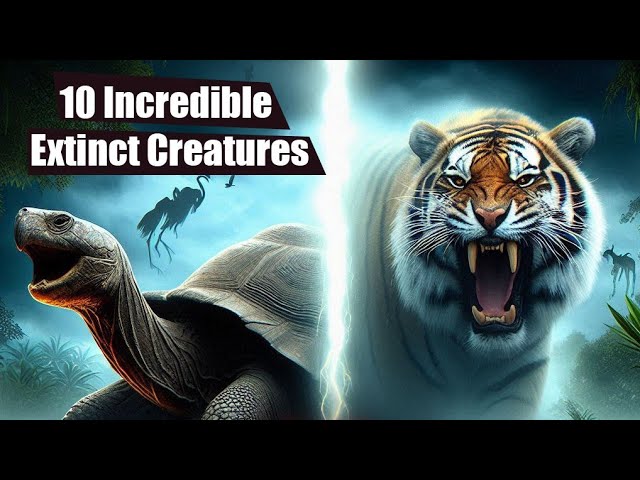Meet Incredible Extinct Creatures of Earth’s Past
Introduction
“Meet Incredible Extinct Creatures of Earth’s Past” as we journey through the prehistoric world to discover some of the most fascinating beings that ever lived. From the mighty Tyrannosaurus Rex to the massive Megalodon, these creatures have left an indelible mark on history and continue to captivate our imaginations.
- Unveiling Earth’s Lost Giants
Throughout Earth’s history, various giants have ruled different eras. These incredible extinct creatures ranged from gigantic dinosaurs to enormous marine predators, each playing a significant role in their ecosystems. Understanding these giants helps us appreciate the diversity and complexity of life that once existed. By studying their remains, we can piece together the story of their lives, behaviors, and eventual extinction.
- The Importance of Studying Extinct Creatures
Studying extinct creatures is crucial for several reasons. It helps us understand the evolutionary processes that have shaped current biodiversity. Additionally, it provides insights into past environmental changes and how different species adapted to them. Learning about these incredible extinct creatures of Earth’s past also highlights the importance of conservation efforts to protect the species that still inhabit our planet today. Their stories remind us of the delicate balance of life and the impact of natural and human-induced changes.
Prehistoric Predators
- Tyrannosaurus Rex: King of the Dinosaurs
The Tyrannosaurus Rex, or T. Rex, is possibly the most famous dinosaur ever to have roamed the face of the earth. Often referred to as being 40 feet long, 12 feet tall at the hip and weighing around 3-6 tons, T. Rex possessed the most powerful bite force ever for any meat eating dinosaur, and no other animal, mammal or dinosaur terraformed this planet at the time it roamed the world.. Living approximately 68 to 66 million years ago, this carnivorous dinosaur roamed the late Cretaceous period’s forests and plains. Fossil evidence suggests that T. Rex had keen senses and strong muscles, making it a formidable hunter. “Meet Incredible Extinct Creatures of Earth’s Past” as we delve into the life and legacy of this legendary dinosaur.
- Spinosaurus: The Aquatic Menace
Spinosaurus, another colossal predator, stands out for its unique adaptations to both land and water environments. With a sail-like structure on its back and elongated jaws filled with conical teeth, Spinosaurus was well-equipped to hunt fish and other aquatic prey. Living around 112 to 93 million years ago, this dinosaur inhabited the river systems of what is now North Africa. Recent discoveries suggest that Spinosaurus spent much of its time in water, making it one of the few semi-aquatic dinosaurs known. “Meet Incredible Extinct Creatures of Earth’s Past” and explore the fascinating world of Spinosaurus, the aquatic menace.
Majestic Mammals
- Woolly Mammoth: The Ice Age Giant
The Woolly Mammoth is one of the most well-known extinct mammals, often associated with the Ice Age’s frozen landscapes. These giant herbivores, covered in thick fur and equipped with long, curved tusks, roamed the vast plains of Eurasia and North America. Living until about 4,000 years ago, Woolly Mammoths played a crucial role in their ecosystems by influencing vegetation patterns and supporting other species. “Meet Incredible Extinct Creatures of Earth’s Past” as we journey into the Ice Age and uncover the life of the majestic Woolly Mammoth.
- Saber-Toothed Tiger: The Fearsome Feline
The Saber-Toothed Tiger, or Smilodon, is famous for its elongated canine teeth, which could grow up to 7 inches long. These fearsome predators lived during the Pleistocene epoch, around 2.5 million to 10,000 years ago, and primarily inhabited the Americas. Saber-Toothed Tigers were built for power, with robust forelimbs and a muscular build, allowing them to take down large prey such as bison and mammoths. “Meet Incredible Extinct Creatures of Earth’s Past” as we explore the life and hunting strategies of the Saber-Toothed Tiger, one of history’s most formidable felines.
Marine Marvels
- Megalodon: The Massive Shark
Megalodon, the largest shark ever known, ruled the oceans approximately 23 to 3.6 million years ago. This colossal predator could grow up to 60 feet in length, with teeth the size of an adult human’s hand. Megalodon’s diet likely consisted of large marine mammals, such as whales and dolphins. Fossil evidence suggests that this massive shark had a widespread distribution, with remains found in diverse locations worldwide. “Meet Incredible Extinct Creatures of Earth’s Past” and dive into the deep to discover the awe-inspiring Megalodon, the ocean’s most fearsome predator.
- Dunkleosteus: The Armored Fish
Dunkleosteus, an ancient armored fish, lived around 358 to 382 million years ago during the late Devonian period. This massive fish, growing up to 33 feet in length, was characterized by its bony armor and powerful jaw muscles. Dunkleosteus could bite through almost anything, making it one of the top predators of its time. Its heavily armored head and robust body provided protection from other predators and facilitated its dominance in ancient marine ecosystems. “Meet Incredible Extinct Creatures of Earth’s Past” as we explore the fascinating Dunkleosteus and its reign in prehistoric oceans.
Avian Wonders
- Argentavis: The Giant Bird
Argentavis, one of the largest flying birds ever known, lived around 6 million years ago in the Miocene epoch. With a wingspan reaching up to 23 feet, this giant bird soared the skies of what is now Argentina. Argentavis likely hunted small mammals and scavenged for carrion, using its keen eyesight to spot prey from great heights. Its impressive size and flight capabilities make Argentavis a remarkable example of avian evolution. “Meet Incredible Extinct Creatures of Earth’s Past” and marvel at the incredible Argentavis, the giant bird of the Miocene skies.
- Haast’s Eagle: The Apex Predator
Haast’s Eagle, once native to New Zealand, was the largest eagle known to have existed. With a wingspan of up to 10 feet and powerful talons, this apex predator hunted large prey, including the now-extinct moa. Haast’s Eagle lived until about 1400 AD, making it one of the more recent additions to the list of incredible extinct creatures. Its hunting prowess and dominance in the skies make Haast’s Eagle a fascinating subject of study. “Meet Incredible Extinct Creatures of Earth’s Past” and uncover the story of Haast’s Eagle, the fearsome avian predator.
These incredible extinct creatures of Earth’s past offer us a glimpse into the planet’s rich and diverse history. Studying their lives, behaviors, and eventual extinction provides valuable insights into the evolutionary processes and environmental changes that have shaped the world we live in today. From the towering Tyrannosaurus Rex to the colossal Megalodon, these beings continue to inspire awe and curiosity, reminding us of the ever-changing nature of life on Earth.
Strange and Unique Creatures
- Glyptodon: The Giant Armadillo
Glyptodon, often described as a giant armadillo, roamed South America during the Pleistocene epoch. With a dome-shaped shell that could reach over five feet in length, this herbivore was well-protected from predators. Glyptodon’s body structure was robust, and it possessed a tail covered in bony rings, adding to its defense mechanisms. These creatures lived in open areas, feeding on grasses and other vegetation. Fossil discoveries of Glyptodon provide valuable insights into the diverse megafauna that once inhabited our planet. “Meet Incredible Extinct Creatures of Earth’s Past” through the lens of the Glyptodon and its unique adaptations.
- Quetzalcoatlus: The Largest Flying Reptile
Quetzalcoatlus, named after the Aztec god Quetzalcoatl, was the largest flying reptile ever known. With an estimated wingspan of up to 40 feet, this pterosaur soared the skies of North America during the late Cretaceous period. Unlike most flying animals, Quetzalcoatlus had a long, stiff neck and a relatively small head compared to its body. Its beak was toothless, suggesting it might have fed on carrion or small animals. The sheer size and distinctive features of Quetzalcoatlus make it a fascinating subject of study. “Meet Incredible Extinct Creatures of Earth’s Past” by exploring the life and flight of Quetzalcoatlus.
Lesser-Known Extinct Species
- Andrewsarchus: The Enigmatic Carnivore
Andrewsarchus is an enigmatic carnivore that lived during the Eocene epoch, approximately 45 to 36 million years ago. Known primarily from a single skull fossil found in Mongolia, this creature is thought to be one of the largest land-dwelling mammalian carnivores. With its massive jaws and sharp teeth, Andrewsarchus likely preyed on smaller mammals and possibly scavenged for food. Its mysterious nature and limited fossil evidence make it a challenging but intriguing subject for paleontologists. “Meet Incredible Extinct Creatures of Earth’s Past” as we delve into the scarce but fascinating world of Andrewsarchus.
- Thylacine: The Tasmanian Tiger
The Thylacine, or the Tasmanian Tiger for short, was a marsupial which was a carnivorous type of animal found in Tasmania, Australia, and New Guinea.. Resembling a large dog with distinctive stripes on its back, the Thylacine was the apex predator in its habitat. It became extinct in the early 20th century, primarily due to hunting and habitat destruction. The last known Thylacine died in captivity in 1936. Despite its extinction, the Thylacine remains an iconic symbol of lost biodiversity. “Meet Incredible Extinct Creatures of Earth’s Past” by reflecting on the life and legacy of the Tasmanian Tiger.
Causes of Extinction
- Natural Disasters and Climate Change
Natural disasters and climate change have played significant roles in the extinction of many species. Events such as volcanic eruptions, asteroid impacts, and shifts in climate have drastically altered habitats and ecosystems. For instance, the mass extinction event at the end of the Cretaceous period, likely caused by an asteroid impact, led to the demise of the dinosaurs. Similarly, the Ice Age brought about significant changes in climate, resulting in the extinction of many large mammals. Understanding these events helps us appreciate the fragile nature of life on Earth. “Meet Incredible Extinct Creatures of Earth’s Past” by examining the natural forces that led to their disappearance.
- Human Activities and Their Impact
Human activities have also contributed to the extinction of numerous species. Deforestation, hunting, pollution, and the introduction of invasive species have disrupted ecosystems and driven many animals to extinction. The Thylacine, for example, was heavily hunted to protect livestock, leading to its extinction. Modern conservation efforts aim to mitigate these impacts and protect endangered species. “Meet Incredible Extinct Creatures of Earth’s Past” while recognizing the ongoing challenges posed by human activities and the importance of sustainable practices.
Importance of Fossil Discoveries
- How Fossils Inform Us About the Past
Fossils are invaluable resources that provide a window into the past, revealing the diversity and evolution of life on Earth. Through the study of fossils, scientists can reconstruct ancient environments, understand the biology and behavior of extinct species, and trace the evolutionary history of modern organisms. Fossil discoveries have led to significant breakthroughs in our knowledge of the natural world, from the development of life to the causes of mass extinctions. “Meet Incredible Extinct Creatures of Earth’s Past” by exploring how fossils continue to unlock the secrets of ancient life.
- Famous Fossil Sites Around the World
Several renowned fossil sites around the world have yielded remarkable discoveries, shedding light on Earth’s prehistoric inhabitants. The Burgess Shale in Canada, for example, is famous for its well-preserved Cambrian fossils, providing insights into early marine life. The La Brea Tar Pits in Los Angeles have produced an extensive collection of Ice Age fossils, including mammoths, saber-toothed cats, and dire wolves. These sites, along with others like the Dinosaur National Monument in the USA and the Messel Pit in Germany, offer invaluable glimpses into ancient ecosystems. “Meet Incredible Extinct Creatures of Earth’s Past” through the treasures unearthed at these famous fossil sites.
Lessons from Extinction
- What Extinction Events Teach Us About Survival
Extinction events teach us critical lessons about survival and the resilience of life. They highlight the importance of adaptability and the ability to thrive in changing environments. Studying past extinctions also underscores the interconnectedness of species within ecosystems and the far-reaching consequences of losing biodiversity. By understanding these events, we can better prepare for and mitigate the impacts of current and future environmental challenges. “Meet Incredible Extinct Creatures of Earth’s Past” and learn from their stories to promote a more sustainable future.
- The Importance of Conservation Today
Conservation efforts today are crucial in preventing further loss of biodiversity. Protecting endangered species, preserving habitats, and promoting sustainable practices are essential strategies in this endeavor. The extinction of creatures like the Thylacine serves as a stark reminder of the consequences of inaction. By supporting conservation initiatives and raising awareness about the importance of biodiversity, we can help safeguard the natural world for future generations. “Meet Incredible Extinct Creatures of Earth’s Past” and be inspired to contribute to conservation efforts today.
Conclusion
- Recap of Incredible Extinct Creatures
From the towering Glyptodon and the massive Megalodon to the enigmatic Andrewsarchus and the iconic Thylacine, Earth’s history is rich with incredible extinct creatures. These beings once roamed our planet, each playing a unique role in their ecosystems. Their stories, uncovered through fossil discoveries and scientific research, provide us with invaluable insights into the past. “Meet Incredible Extinct Creatures of Earth’s Past” by revisiting their fascinating lives and legacies.
- Encouragement to Learn and Explore More
The study of extinct creatures is a journey of discovery that continues to reveal new findings and perspectives. By learning about these incredible beings, we gain a deeper appreciation for the diversity and complexity of life on Earth. I encourage you to explore more about these extinct creatures, visit museums, and engage with scientific literature. Their stories not only captivate our imaginations but also remind us of the importance of preserving the natural world. “Meet Incredible Extinct Creatures of Earth’s Past” and let their legacy inspire you to protect the wonders of our living planet.
FAQs
Q. What are some of the most famous extinct creatures?
Ans “Meet Incredible Extinct Creatures of Earth’s Past” includes well-known species like the Tyrannosaurus Rex, Woolly Mammoth, and Saber-Toothed Tiger, as well as lesser-known ones like the Glyptodon and Quetzalcoatlus.
Q. How did these creatures become extinct?
Ans. Many of these creatures went extinct due to natural disasters, climate change, and human activities. For example, the asteroid impact that ended the dinosaurs’ reign and the Ice Age that wiped out the Woolly Mammoth.
Q. Why is it important to study extinct creatures?
Ans. Studying extinct creatures helps us understand Earth’s history, evolutionary processes, and the impact of environmental changes. It also highlights the importance of conservation to protect current species.
Q. Where can I find fossils of these extinct creatures?
Ans. Fossils of these creatures can be found in famous fossil sites around the world, such as the La Brea Tar Pits in Los Angeles, the Burgess Shale in Canada, and the Dinosaur National Monument in the USA.
Q. What lessons can we learn from extinction events?
Ans. Extinction events teach us about the resilience of life, the importance of adaptability, and the interconnectedness of ecosystems. They also emphasize the need for conservation efforts to protect biodiversity.














Post Comment